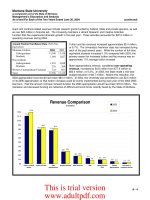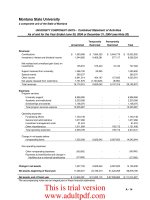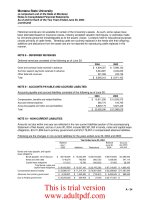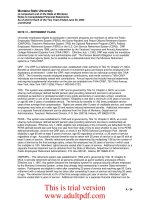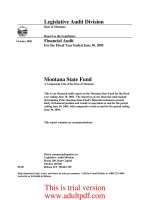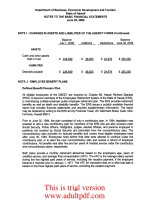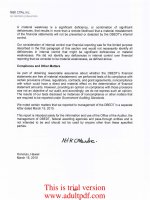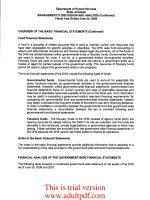Department of Human Services State of Hawaii NOTES TO THE BASIC FINANCIAL STATEMENTS June 30,2008_part3 potx
Bạn đang xem bản rút gọn của tài liệu. Xem và tải ngay bản đầy đủ của tài liệu tại đây (352.94 KB, 10 trang )
PART IV
SCHEDULE OF FINDINGS AND QUESTIONED COSTS
61
This is trial version
www.adultpdf.com
Department
of
Human Services
State
of
Hawaii
SCHEDULE OF FINDINGS AND QUESTIONED COSTS
Fiscal Year Ended
June
30, 2008
SECTION I - SUMMARY OF AUDITORS' RESULTS
Financial Statements
Type
of
auditors' report issued:
Internal control over financial reporting:
Material weakness(es) identified?
Significant deficiencies identified that are
not considered to be material weaknesses?
Noncompliance material to the financial statements
noted?
Federal Awards
Unqualified
:!
yes
_no
:!
yes _ none reported
_ yes
:!
no
Internal control over major program:
Material weakness(es) identified?
Significant deficiencies identified that are
not considered to be material weaknesses?
Type
of
auditors' report issued on compliance for
major programs:
Any audit findings disclosed that are required to be
reported
in
accordance with section .510(a)
of
OMB Circular A-133?
Identification
of
major programs:
:!
yes
:!
yes
Qualified
:!
yes
no
_ none reported
no
CFDA Number
93.558
96.001
93.575
93.596
93.767
93.777
93.778
Name
of
Federal Program
Temporary Assistance for Needy Families
Social Security - Disability Insurance
Child Care and Development Block Grant
Child Care Mandatory and Matching Funds of the Child Care and
Development Fund
State Children's Insurance Program
State Survey and Certification
of
Health Care Providers and Suppliers
Medical Assistance Program
Dollar threshold used to distinguish between Type A
and Type B programs:
$
3,372,107
Auditee qualified as a low-risk auditee?
62
_ yes
./
no
This is trial version
www.adultpdf.com
Department
of
Human Services
State
of
Hawaii
SCHEDULE OF FINDINGS AND QUESTIONED COSTS (Continued)
Fiscal Year Ended
June
30,
2008
SECTION
11-
FINANCIAL STATEMENT FINDINGS
Ref.
No. Internal Control Findings
2008-01 Revise Federal
Award
Reimbursement
Process
We identified
an
accounting error
in
the DHS basic financial statements
as
of and for
the fiscal years ended June
30,
2008 and 2007. The Med-QUEST Division (MQD)
understated the amount receivable from the federal government by approximately
$33.6 million and $41.2 million as of June
30,2008
and
2007, respectively. There was
no effect
on
the previously reported fund and net asset balances of the DHS
as
of
June
30,
2007 because the receivable from the federal government was a
reimbursement of previously expended State funds that were earned
in
the 2007 fiscal
year and therefore was due back to the State Treasury. The understatement
in
the
fiscal year 2008 financial statements was identified
and
subsequently adjusted for. The
error occurred due to a lack of periodic reconciliations of the DHS revenue and
expenditure accounts to the amounts of federal awards that were drawn down.
The MQD administers the Medicaid Program for the State of Hawaii. Costs of the
Medicaid program are first paid from allotments of State general funds after which
MQD requests reimbursements from federal grant awards based
on
a Federal
Participation rate of approximately 58% (Certain expenditures do not qualify for federal
reimbursements while other expenditures are reimbursed at higher rates). This cost
reimbursement basis
is
a federal compliance requirement.
In
complying with this
federal requirement, the DHS initially uses its general funds to pay for the federal
share of the expenditures and reimburses the general fund once the federal funds are
received.
The Medicaid program
is
the largest federally funded program administered by the
DHS (approximately $730 million
in
federal funds for the fiscal year ended June
30,
2008) and the amount of federal funding earned by the State
is
generally based
on
a
Federal Medical Assistance Percentage rate (FMAP) multiplied by the amount of
expenditures incurred during the quarter. The Medicaid program awards the MQD
an
estimated federal award at the beginning of each quarter based
on
the MQD's request
for funding. Subsequent to filing the quarterly federal reports, supplemental federal
awards are granted to increase or decrease the total federal award to equal the
amount of federal reimbursements earned based
on
reports of actual expenditures
made. At times, these supplemental awards may not be made available to the DHS to
draw down and receive the reimbursement until three to six months following the end
of a quarterly reporting period. If the initial quarterly award
is
not sufficient to cover the
federal share of expenditures, MQD continues to use its State general funds to
advance the federal share of the expenditures until federal funds become available.
63
This is trial version
www.adultpdf.com
Department
of
Human Services
State
of
Hawaii
SCHEDULE
OF
FINDINGS AND QUESTIONED COSTS (Continued)
Fiscal Year Ended June
30,
2008
Ref.
No. Internal Control Findings (Continued)
2008-01 Revise Federal Award Reimbursement Process (Continued)
We noted that during the fiscal year ended June
30,
2008, the MOD received
approximately $18.6 million more
in
federal reimbursements during the year than what
it reported as earned for the current fiscal year.
Upon
further investigation, it was
determined that the funding received was for federal reimbursements earned
in
the
prior fiscal years. A reconciliation of federal awards drawn down during the past two
fiscal years to the amount of federal revenues recognized during that period was
performed and it was determined that the approximately $33.3 million and $53.3
million was receivable from the federal government as of June
30,
2008
and
2007,
respectively.
The lack of quarterly reconciliations, including a complete review and approval of such
reconciliations, affected the DHS's ability to accurately report federal revenues earned
which resulted
in
a material understatement of revenues and amounts receivable
in
the special revenue funds.
Recommendation
The MOD should develop a reconciliation process between the quarterly federal
reports and the amounts recorded
in
the DHS's financial records. This process should
be
done
i~
a timely manner and include a subsequent review and approval of such
reviews. Management of the
DHS
should determine whether sufficient
and
appropriate
accounting staffing
is
available at the MOD to properly complete reconciliations
in
a
timely manner.
We also recommend that management review
the
process used
to
request the
estimated quarterly federal award to ensure that the amount awarded
is
sufficient to
reimburse the federal share of estimated expenditures
on
a timely basis.
An
increase
in
the initial award would reduce the amount of State general funds that would need to
be
advanced until the supplemental federal awards
are
received.
64
This is trial version
www.adultpdf.com
Department
of
Human Services
State
of
Hawaii
SCHEDULE
OF
FINDINGS AND QUESTIONED COSTS (Continued)
Fiscal Year Ended June
30,
2008
Ref.
No. Internal Control Findings (Continued)
2008-02
Report
All
Federal
Programs
During our tests of the Schedule
of
Expenditures of Federal Awards (SEFA) for the
fiscal year ended June
30,
2008,
we
noted that expenditures related to the
Demonstration to Maintain Independence and Employment grant was not included
in
the SEFA for the fiscal year ended June
30,
2007.
As
a result, the 2007 SEFA was
understated by $301,984. The Med-QUEST Division had expended federal funds for
this grant during the fiscal year ended June
30,
2007, but did not include those
expenditures
in
its SEFA as required
by
U.S.
Office of Management
and
Budget
Circular A-133,
Audits
of
States, Local Governments and Non-Profit Organizations.
This omission was not detected
by
review procedures performed
on
the SEFA
by
DHS
management.
Recommendation
The
DHS
should establish procedures to ensure that
all
expenditures of federal
awards are properly reported
in
the Schedule of Expenditures of Federal Awards. The
personnel responsible for the preparation
and
review
of
the SEFA should have ready
access to all financial reports filed for all programs which receive federal funding.
In
addition, a list of all federal awards expended should
be
circulated
and
reviewed by
appropriate personnel
in
each division of
DHS
for completeness and accuracy
as
part
of the review process.
65
This is trial version
www.adultpdf.com
Department
of
Human Services
State
of
Hawaii
SCHEDULE
OF
FINDINGS AND QUESTIONED
COSTS
(Continued)
Fiscal Year Ended June
30,
2008
Ref.
No. Internal Control Findings (Continued)
2008-03 Properly Record All Capital Assets in the State Property Inventory Records
All divisions of the
DHS
are responsible for reporting the acquisition
and
disposal of
capital assets to the State Procurement Office
on
a quarterly basis to update the state
property inventory records. The Department of Accounting
and
General Services
(DAGS) uses the information from the state property inventory records
to
assist the
DHS
in
compiling the department's capital assets
and
depreciation information for the
fiscal year. We noted that during the fiscal year ended June
30,
2008, the
DHS
reported $269,260
in
capital asset additions ($190,341, net of accumulated
depreciation) that were purchased
in
prior fiscal years.
In
addition,
we
noted that
$857,635 of capital acquisitions were recorded
as
repairs
and
maintenance
expenditures and not properly included
in
the state property inventory records
in
the
current fiscal year.
Section 103D-106 of the Hawaii Revised Statutes states
in
part, " the administrative
heads of the executive departments,
and
all
other persons, offices,
and
boards of a
public character shall prepare
and
file with the administrator of the state
procurement office
an
annual inventory return of state property
in
the possession,
custody, control, or use of the officer making the return, or of the department or office
of the government over which the officer presides "
Although the
DHS
has issued reminders to
all
division offices to properly report capital
asset purchases to the State Procurement Office, the DHS's personnel
did
not always
adhere to the established procedures.
Recommendation
To ensure that the state property inventory records are complete
and
accurate, the
DHS
should implement monitoring procedures to ensure that
all
appropriate personnel
accurately report
all
fixed asset acquisitions
and
dispositions
to
the State Procurement
Office
on
a quarterly basis. The DHS should also implement a process to review,
in
a
timely manner, the transactions that are posted to
the
department property inventory
records to ensure that acquisitions
and
dispositions were properly posted to the state
property inventory records.
66
This is trial version
www.adultpdf.com
Department
of
Human Services
State
of
Hawaii
SCHEDULE OF FINDINGS AND QUESTIONED COSTS (Continued)
Fiscal Year Ended
June
30, 2008
Ref.
No. Internal Control Findings (Continued)
2008-04 Maintain
Vacation
and
Sick
Leave Records Properly
The DHS prepared a summary leave schedule to compute its accrued compensated
absence liability balance and reported the liability to the State Comptroller. The liability
was based on the balance of earned hours per individual leave records (Form DPS-7)
multiplied by each employee's hourly salary rate. The DHS uses a manual process to
maintain and report the vacation and sick leave records which resulted
in
errors
in
the
amount of hours and dollars reported to the State Comptroller. The following were the
conditions noted during our review of 25 vacation and sick leave files:
• There were six instances where the vacation leave hours per the employee's Form
DPS-7 did not agree to the "Vacation and Sick leave Accrual Listing"
as
of June
30,
2008. This resulted
in
a net understatement of accrued vacation totaling 5.25 hours
or $103.
• There were four instances where the vacation or sick leave hours per the
employee's Form DPS-7 did not agree to the "Vacation and Sick leave Accrual
Listing" as of June
30,
2008. This resulted
in
a net understatement of accumulated
sick leave totaling 1.50 hours or $17.
• There were four instances where the vacation hours per the employee's Form
DPS-7 did not agree to the "Application of Leave of Absence" (Form G-1) filed for
the period tested. This resulted
in
a net understatement of accrued vacation leave
totaling 5.25 hours or $66.
• There was one instance where the sick hours per the employee's Form DPS-7 did
not agree to the "Application of Leave of Absence" (Form G-1) filed for the period
tested. This resulted
in
an understatement of accumulated sick leave totaling 1.75
hours or $45.
Although the DHS established procedures to conduct random quality control reviews
of leave records, it appears that the leave records were not always updated accurately
on
a timely basis.
Recommendation
We recommend that the amounts of vacation and sick leave balance being reported
are validated against personnel and payroll records to ensure accuracy and
completeness before reporting the balance to the State Comptroller. The DHS should
also increase the number of random quality control reviews of leave records to ensure
that vacation and sick leave records are accurately maintained
on
a timely basis.
67
This is trial version
www.adultpdf.com
Department
of
Human Services
State
of
Hawaii
SCHEDULE
OF
FINDINGS AND QUESTIONED
COSTS
(Continued)
Fiscal Year Ended June
30,
2008
Ref.
No. Internal Control Findings (Continued)
2008-05 Maintain Procurement Files Properly
Divisions within the
DHS
are responsible for following the guidelines of the State
Procurement Office, which serves
as
the central authority
on
procurement statutes
and
rules for
all
governmental bodies of the State.
Federal regulations
(45
CFR
74.46) requires the
DHS
to maintain documentation
supporting the history of the procurement process including the rationale for method of
procurement, selection of contract type, contractor selection or rejection,
and
the basis
of contract price. Section 103F-402 of the Hawaii Revised Statutes states that
proposals are to
be
evaluated with criteria that are made known to the applicant during
the initial request for proposals. The following were the conditions noted during our
review of 25 procurement files:
• There were two instances where the
DHS
was unable to locate the
documentation supporting the rationale of
the
contractor selected. The two
contracts were awarded federal funds under CFDA 93.778 Medical Assistance
Program.
Although the
DHS
has established policies
and
procedures within each division
to
comply with State procurement statutes, it appears that not
all
contracts were reviewed
to ascertain the completeness of the files.
Recommendation
We recommend that prior to contractor acceptance, the
DHS
implement a review
process to ensure procurement files contain
all
documentation
as
required
by
State
and
federal procurement statutes.
68
This is trial version
www.adultpdf.com
Compliance
and
Internal
Control
Findings
Department
of
Human
Services
State
of
Hawaii
SCHEDULE OF FINDINGS AND QUESTIONED COSTS (Continued)
Fiscal Year Ended
June
30, 2008
SECTION
III
- FEDERAL AWARD FINDINGS AND QUESTIONED COSTS
Ref.
No.
2008-06 Improve
Controls
over
Utilization, Fraud
and
Accuracy
of
Medicaid
Claims
Federal agency: U.S. Department of Health and Human Services
CFDA 93.778
Medical Assistance Program
The development and administration
of
the State's Medicaid Assistance
Program (MAP) is the responsibility
of
the Med-OUEST Division (MOD).
The DHS information retrieval and non-drug claims processing system
is the Hawaii Prepaid Medical Management Information System
(HPMMIS). The HPMMIS is operated and maintained by the Arizona
Health Care Cost Containment System (AHCCCS).
In
addition, the
management and processing of the DHS's pharmacy benefits is
contracted to Affiliated Computer Services, Inc. (ACS).
Due to the complexity
of
the Medicaid program operations and the large
volume
of
transactions, much reliance is placed
on
HPMMIS and its
system of internal controls to accurately maintain enrollment and
participant data and to ensure Medicaid costs are allowable, properly
coded and accurately paid. Title 42 CFR Part 456 Subpart A requires a
statewide program of control
of
the utilization
of
all Medicaid services.
During our review
of
internal controls, we noted that the primary
controls used to prevent unnecessary utilization
of
care and services
and to ensure proper and accurate payment
of
Medicaid claims were
front-end controls such as pre-payment edit functions contained
in
HPMMIS and an extensive list
of
medical services and procedures
which require prior authorization. However, we noted a lack
of
back-end
control activities such as a post payment review
of
a sample of
Medicaid claims
or
a review
of
utilization data for potentially fraudulent
or
abusive activity. Furthermore, for certain back-end control activities
performed by the quality improvement organization (010) formerly
known as peer review organization, we noted a lack of follow-up by the
DHS on findings and recommendations reported.
More specifically, we noted the following conditions:
• The Surveillance and Utilization Review SUbsystem (SURS)
reports are still not being used to identify potential fraud or abuse.
During much of fiscal year 2008, SURS personnel were assigned
69
Questioned
Costs
This is trial version
www.adultpdf.com
Ref.
No.
Department
of
Human Services
State
of
Hawaii
SCHEDULE OF FINDINGS AND QUESTIONED COSTS (Continued)
Fiscal Year Ended
June
30, 2008
Compliance and Internal Control Findings (Continued)
Questioned
Costs
2008-06 Improve Controls
over
Utilization, Fraud and Accuracy
of
Medicaid
Claims (Continued)
to perform prior authorization functions.
In
February 2008, the prior
authorization function was contracted to ACS and three full-time
SURS personnel were available by April 2008. However, based
on
discussion with SURS personnel there
is
a lack of meaningful, user-
friendly SURS reports needed to identify potential fraud and abuse
cases. As a result, there were no cases referred to the Medicaid
Fraud Control Unit (MFCU) which operates under the State Attorney
General's office based on the review of SURS reports. Any referrals
from the SURS unit
in
fiscal year 2008, originated from public phone
calls reporting potential fraud or abuse. The DHS continues to
be
in
noncompliance with Title 42 CFR Part 456.23, which requires the
DHS to have a post payment review process that allows state
personnel to review recipient utilization and provider service profiles
and exception criteria to identify and correct misutilization practices
of recipients and providers.
• The DHS continues to
be
in
noncompliance with Title 42 CFR Part
455.13 which requires the DHS to have methods for identification,
investigation, and referral of fraudulent activity. The Medicaid
Investigations Unit (MIU)
is
responsible for these activities.
In
the
past,
this unit was comprised of one individual and
in
June 2008, this
individual went
on
medical leave, has since left the
DHS
and to date
the position remains vacant. The DHS currently
has
almost
no
formal
activities to identify suspected fraud. Referrals of potential fraudulent
activities to the
MFCU
only originate from complaints received
via
the
MOD phone
line.
In
an
August 2006 report issued by the Centers for
Medicare and Medicaid Services (CMS) the
U.S.
federal agency which
administers the Medicaid program, the DHS was cited for a lack of
communication
and
coordination of efforts with the
MFCU.
There
appears to
be
no
improvement
in
this condition
• There
is
no
formal ongoing post payment review of a sample of
claims.
It
has been over five years since the last third party review was
performed, which focused
on
pharmacy claims
and
the monitoring of
ACS,
its
pharmacy benefits manager (PBM). That report issued
by
an
independent healthcare auditing
and
consulting company reported
potential overpayments of approximately $462,000
and
recommended
the need to explore additional edits, analysis, and reporting
in
order to
70
This is trial version
www.adultpdf.com

